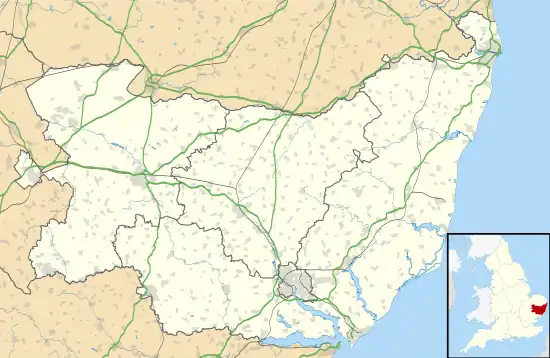| Old Town Hall | |
|---|---|
.jpg.webp) Old Town Hall, Needham Market | |
| Location | High Street, Needham Market |
| Coordinates | 52°09′13″N 1°03′06″E / 52.1535°N 1.0518°E |
| Built | 1866 |
| Architect | Frederick Barnes |
| Architectural style(s) | Italianate style |
Listed Building – Grade II | |
| Official name | The Old Town Hall |
| Designated | 24 August 1977 |
| Reference no. | 1253656 |
 Shown in Suffolk | |
The Old Town Hall is a municipal building in the High Street in Needham Market, Suffolk, England. The building, which now accommodates an antiques centre and other shops, is a Grade II listed building.[1]
History
The building was commissioned by a group of businessmen, led by Admiral Sir George Broke-Middleton of Shrubland Hall, who set up a private company to finance and commission a municipal building for the benefit of the town.[2] The site they selected, which was in the High Street, was occupied by a cottage which had been the birthplace of the artist, Samuel Read.[3][4] The building was designed by Frederick Barnes in the Italianate style, built by a local contractor, H. Godfrey, in red and buff bricks at a cost of £1,300 and was completed in late 1866.[1]
The design involved a symmetrical main frontage with three bays facing onto the High Street. The central bay, which slightly projected forward at ground floor level, featured a round headed entrance with imposts supporting an architrave: there were three deeply-recessed narrow round headed windows on the first floor. The outer bays were fenestrated by tripartite sash windows on the ground floor and by single deeply-recessed round headed windows on the first floor. At roof level, there was a parapet and a modillioned cornice, while the corners were decorated by full-height piers surmounted by small pediments. Internally, the principal rooms were the lecture room, which was at the front of the building on the first floor, a courtroom, a public library and a reading room. There were also offices for the local police officers and a lock-up for petty criminals.[5]
A commemorative stone, recording Broke-Middleton's patronage, as well as the names of the architect and the builder, was installed above the entrance by Broke-Middleton himself in June 1866.[6] The architectural historian, Nikolaus Pevsner, was unimpressed with the design and referred to it as "a sad building of yellow and red brick with lean round arches".[7]
In the 19th century, the courtroom was used for fortnightly petty session hearings for the Bosmere and Claydon Hundred, one of the ancient hundreds of Suffolk.[8] During the Second World War, the town hall narrowly missed being demolished on 19 October 1942 when a German bomb fell on a site just to the south of the building, killing four civilians and injuring many more.[9][10] The company which had financed and commissioned the building was wound-up in 1948[11] and the building was subsequently converted for commercial use: it has since been used by a variety of local businesses including a publishing house[12] and an antiques centre.[13][14]
References
- 1 2 Historic England. "The Old Town Hall (1253656)". National Heritage List for England. Retrieved 24 April 2022.
- ↑ "Needham Market Town Hall Company". National Archives. Retrieved 24 April 2022.
- ↑ "History". Needham Market Town Council. Retrieved 24 April 2022.
- ↑ "Suffolk: Needham Market: Town's famous sons and daughters". East Anglian Daily Times. 1 October 2011. p. 67. Retrieved 24 April 2022.
- ↑ "Provincial News: Needham Market". The Builder. Vol. 24. 30 June 1866. p. 485. Retrieved 24 April 2022.
- ↑ "New Town Hall at Needham Market". Illustrated London News. 30 June 1866. p. 649. Retrieved 24 April 2022.
- ↑ Pevsner, Nikolaus (1961). Suffolk (Buildings of England Series). Penguin Books. p. 345.
- ↑ "Needham Market". Kelly's Directory of Suffolk. 1900. Retrieved 24 April 2022.
- ↑ "The Bombing" (PDF). Needham Market Newsletter. 1 May 2021. p. 7. Retrieved 24 April 2022.
- ↑ "Conservation Area Appraisal: Needham Market" (PDF). Babergh Council. p. 13. Retrieved 24 April 2022.
- ↑ "No. 38210". The London Gazette. 17 February 1948. p. 1140.
- ↑ British Books in Print. J. Whitaker & Sons. 1985.
- ↑ Miller, Judith; Miller, Martin; Murfin, Robert (1991). Miller's Collectables Price Guide. Vol. 4. p. 504. ISBN 978-1851526819.
- ↑ The Daily Telegraph Guide to the Antique Shops of Britain 2000-2001 With Fairs, Auctions, Packers and Shippers. Antique Collectors' Club. 2000. p. 760. ISBN 978-1851493425.